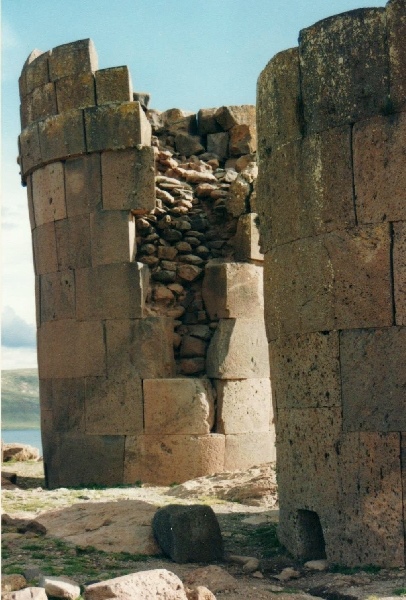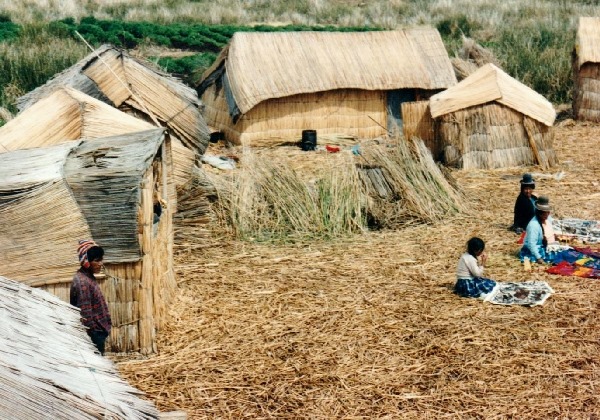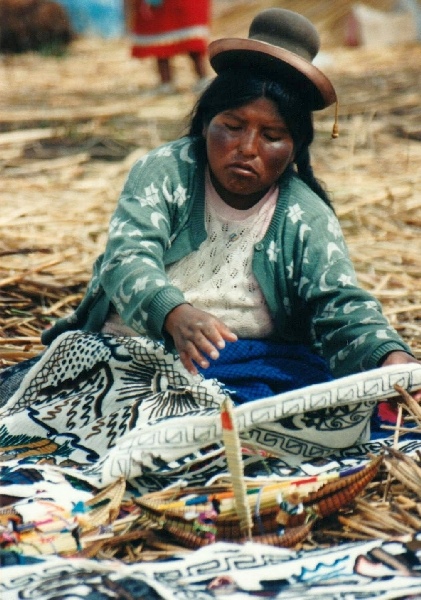World traveler Clown Tom Bolton
Adventure stories & photos

Tom’s second travel to Peru, South America
Colca Canyon & Chivay
On my second trip to Peru in 1996, I only stayed about 10 days seeing the south before continuing on to Bolivia. I flew into Lima and on to Arequipa in the south of Peru. From there I took a bus into the highlands, climbing the altiplano and going through considerable amounts of snow before descending to Chivay, which is a good base to visit the Colca Canyon and do walks in the valley. As seen below, the canyon is typically shrouded in mist. It is not particularly wide but is the deepest canyon in the world. The mid-day sun managed to burn away some of the fog yet clear views of the bottom weren’t to be had while I was there.
A big attraction at Colca Canyon is to spot condors soaring through the mist taking advantage of the updrafts. I got some clear photos of the 3 condors I saw but they are very far away. I’m including this one which was close by and although it was misty, that just added to the mystique. As the mist lifted a bit I could get better views of both the condors and spot the river at the bottom of the canyon.There were also some other nice images by the canyon like the cross and seeing the local visitors.
Walking around Colca Canyon area
I strolled the roads around Colca Canyon enjoying the scenery. Locals were alos on the road herding their cattle, donkeys and mules. One also saw small villages with similar styled churches. The one had major earthquake damage.
Peruvian highlands terrain
My travels through Peru were on rickety old buses, many of which were old American school buses. The people there are relatively small but it is still cramped to be in vehicles made to transport kids. Like in the picture, many of the mountains were terraced for agriculture. But such slopes don’t lend themselves well to use of tractors even if the people could afford them so people seemed destined to scratching out a living on small plots of land. Places like Colca Canyon have a special attraction but much of the terrain throughout the highlands spectacular whether it was a nature park or like here domesticated.
Carnival celebrations
Like in most of Latin America, there are lots of public celebrations at Carnival time. The celebrations, photographed below had started while I was in Chivay to visit the Colca Canyon and continued on the following days. Chivay was a very rural village whose population seemed to be exclusively poor but colorful Indians.
Lake Titicaca, Puno & Sillustani ruins
Although a longer distance, the best way to continue on to my next destination, the city of Puno on the north shore of Lake Titicaca, was to go down to Arequipa and take a train back up. I based myself in the town of Puno from which I made many excursions, like visiting the ruins of Sillustani, which I found attractive but nothing majestic. This site overlooks Lake Umayo, a much smaller lake east of Titicaca. There are circular funeral towers called chullpas, which are found throughout the Andes, but the bigger ones here were built in a very complex method unique to the local Colla tribe.
Chullpas – great viewpoints
There were also many small, basic chullpas like these pictured here. The artifacts were pretty basic but what a view. Was a common factor to most religiously associated ruins that they had great outlooks, which makes for sensible defense but I tend to think they were primarily chosen for their inspirational natural beauty.
Alpaca herders at Sillustani
Something else that caught my eye at the Sillustani site was a number of alpaca herders grazing their animals amongst the ruins. Even archeological sites have dual purposes in a country where there is some kind of artifact nearly everywhere you look. This seems to bring up the question of resource allocation. What is really worth protecting? I’m sure the food and wool from the alpacas impact the locals lives more than some of the marginal piles of old stones.
Taquile Island, Uros floating islands
I then visited the island of Taquile in the north central part of Titicaca where nearly everything was closed for the holidays. From Puno I also took a “floating island tour“. There are groups of Uro Indians that live on artificial islands in that region of the lake. The islands, houses and boats were all constructed out of totara reeds whose inner part near the roots is both edible and used for medical purposes. Seemed like an unpractical place to live but maybe it was easier to defend against attack in times past. Images include a guy poling along in his traditional reed boat, local sailboats, the reed houses and underground. Also Uro Indian women selling souvenirs to tourists, which seemed to be their main occupation supplanting the catching of fish and birds. From Puno I went across Titicaca on into Bolivia.
So, those were just a few tales from my many travels over the last thirty and something years. I hope you've enjoyed another side of a traveling clown! If you want, write me an email or better yet, book my show or set a link to this website or just state me as the beneficiary of your will!
To book or see more information about Tom's clown show and entertainment, visit one or both of his clown websites:
Clown Stuttgart www.clowntombolton.com
Clown juggler Stuttgart, Gremany www.clown-event.de





















































